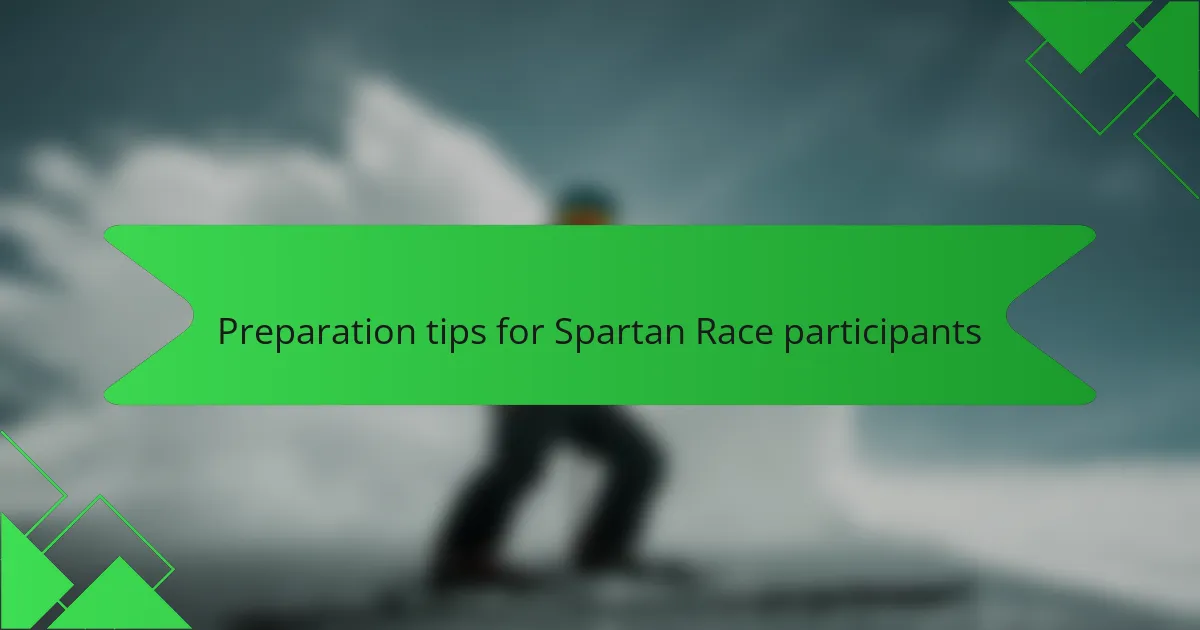Key takeaways
- Obstacle course racing (OCR) combines various physical activities like running, climbing, and crawling, providing a diverse and challenging experience.
- Course design in Spartan Races features a mix of natural terrain and man-made obstacles, emphasizing adaptability and strategic thinking.
- Preparation involves building grip strength, practicing transitions between movements, and maintaining mental focus to overcome challenges during the race.
- Key lessons from Spartan Races include the importance of pacing, mental toughness, and adaptability to conquer obstacles effectively.

Introduction to obstacle course racing
Obstacle course racing, or OCR, is unlike any workout I’d tried before; it’s a blend of running, climbing, crawling, and sometimes even swimming—all wrapped into one challenging adventure. Have you ever wondered what it feels like to push your body beyond its usual limits while navigating unpredictable terrain? For me, OCR turned exercise into a thrilling mental and physical puzzle.
What really drew me in was the variety. One moment you’re scaling a wall, and the next you’re sloshing through muddy water—there’s no room for boredom here. That unpredictability kept me hooked, always wondering what obstacle would come next and how I could conquer it. It’s not just about speed; it’s about strategy and grit.
And let’s be honest, the sense of accomplishment at the finish line is something I still chase. OCR forces you to face your fears head-on and find out what you’re really made of. Have you ever finished a race thinking, “I can’t believe I just did that”? That feeling is what makes obstacle course racing addictive in the best way.

Key features of Spartan Race courses
One thing I immediately noticed about Spartan Race courses is how thoughtfully varied the obstacles are. They mix natural elements like hills and mud with man-made challenges such as walls and monkey bars, creating a balanced test of strength, agility, and endurance. Have you ever tried climbing a rope only to discover your grip wasn’t as strong as you thought? That moment stuck with me—it’s where the course design truly pushes you to adapt on the fly.
The layout itself isn’t just random chaos; it flows in a way that keeps you mentally sharp. You’re sprinting one minute, then forced to slow down and strategize the next. I remember a section where after a fast downhill run, a series of tough upper-body obstacles awaited me. It was a rude surprise but perfectly designed to shake up your rhythm. This constant switching between effort types makes the race feel fun and exhausting at the same time.
Another feature that stood out was how the courses often incorporate natural terrain challenges that feel authentic rather than staged. Mud pits, river crossings, and steep slopes are all part of the challenge, blending seamlessly with the obstacles. It reminded me that Spartan Races aren’t just about muscles—they test your ability to face real-world elements and keep going. Doesn’t that kind of challenge make crossing the finish line feel that much more rewarding?

Common challenges in Spartan races
One challenge I kept running into during Spartan Races was managing the grip strength needed for obstacles like monkey bars and rope climbs. I remember struggling halfway up a rope, my hands slipping, and feeling that mix of frustration and determination—it’s a test that goes beyond just brute strength. Have you ever realized that your hands can be the weakest link when you thought your legs were? That moment really made me focus on building grip endurance.
Another hurdle is dealing with unpredictable terrain. One minute you’re sprinting on a flat path; the next, you’re scrambling up a muddy hill that’s deceptively slippery. The sudden shifts in footing always caught me off guard, forcing me to adjust my balance instantly. It’s that unpredictability that keeps you mentally alert but also wears you down physically.
Finally, the sheer variety and sequencing of obstacles can drain your energy in unexpected ways. After pushing through a brutal carry or crawl, the course might throw in a wall climb that demands a completely different muscle group. I found myself frequently asking, “How am I supposed to recover so fast?” yet forced to keep moving. This constant demand for adaptability is what makes Spartan Races so challenging—and, honestly, so rewarding.

Preparation tips for Spartan Race participants
When preparing for a Spartan Race, I learned that building grip strength early on makes a huge difference. Have you ever been halfway up a rope only to feel your hands slipping? Training with exercises like dead hangs and farmer’s carries helped me avoid that frustrating moment more than once.
I also found that practicing transitions between different movements is key. It’s one thing to be strong on a sprint or a wall climb alone, but switching quickly from running to crawling or lifting tests your body in new ways. Incorporating circuit training with varied obstacles prepared me to handle those sudden shifts without losing momentum.
Lastly, don’t underestimate the mental game. I used visualization techniques before races, picturing myself tackling tough obstacles calmly rather than panicking. When fatigue hit mid-race, that mental focus pushed me through. Have you ever noticed how your mindset can sometimes make or break your performance? For me, that mental edge was just as critical as physical readiness.

My insights on Spartan Race course design
What struck me most about Spartan Race course design is how deliberately they balance toughness with flow. Each obstacle feels like part of a bigger puzzle — just when you think you’ve caught your breath, the course nudges you toward another test, keeping your mind engaged as much as your body. Have you ever noticed how that kind of pacing makes the experience feel more like an adventure than a mere race?
I also appreciated how the designers use natural terrain to their advantage. The way hills, mud, and water integrate seamlessly with the obstacles makes the course feel authentic and challenging in a way that’s different from a typical gym workout. For me, this connection to the environment deepened the sense of accomplishment, turning every muddy slog into a story worth telling.
One memorable example was a section where after an intense uphill climb, the course led straight into a series of grip-heavy obstacles. My arms were shaking, but the way the sequence pushed me to tap into different strengths showed how intentional the layout really is. Have you experienced moments in a race where your body surprises you just by refusing to give up? That’s Spartan Race course design working its magic.

Lessons learned from Spartan Race experiences
One lesson that hit me hard was the importance of pacing. Early on, I’d blast through the running parts only to totally drain myself before the technical obstacles appeared. Have you ever sprinted full throttle only to face a tough wall climb and felt completely spent? Learning to balance effort and conserve energy made the difference between finishing strong and hitting a wall—literally and figuratively.
I also realized that mental toughness is just as crucial as physical strength. I remember a moment when I wanted to quit after failing the monkey bars multiple times. What kept me going was reminding myself that every fall was just part of the process. Have you ever caught yourself negotiating with your mind during a race? That inner dialogue became my secret weapon, turning frustration into fuel.
Lastly, adaptability stood out as a key takeaway. Spartan courses throw curveballs at every turn—muddy slopes after a sprint, or heavy carries right after an obstacle that taxed different muscles. I learned to listen closely to my body and adjust my technique on the fly. Have you noticed how being flexible in your approach often opens doors that brute force alone can’t? For me, this lesson transformed how I tackle not just races but challenges in everyday life.

Recommendations for future Spartan racers
If you’re gearing up for your first Spartan Race, my biggest advice is to focus on versatile training. Have you ever tried mastering just one type of obstacle, only to find the next challenge demands a completely different skill? I learned this the hard way when I over-prepared for running but underestimated the grip-heavy sections—I wish I’d balanced my workouts sooner.
Don’t forget to pace yourself during the race. I used to start off too fast, feeling invincible, only to hit exhaustion halfway through. Have you ever felt that sudden wave of fatigue after an adrenaline high fades? Slowing down strategically can actually help you finish stronger and enjoy the experience more.
Finally, embrace the unexpected. Spartan courses love to throw surprises that mess with your rhythm—muddy climbs after sprinting or slippery descents just when you think you’re done. I remember thinking, “Not again!” but those curveballs became moments where I discovered new strengths. Are you ready to welcome those challenges as part of your race story? Because that mindset makes all the difference.
